Reviews of film ephemera, including such things as educational films, industrial films, military and propaganda films, tv commercials, movie trailers, shorts, experimental films, and movies made for non-mainstream audiences.
Armour Franks Intermission Trailer (available on Vintage Ads. Also available on You Tube).
Snack bar promo from the 50s featuring a bouncy, catchy jingle for Armour Franks that asserts, among other things, that they are “fun to eat when dating.” I’m sure the 14-year-old boy in all of us is having fun with the implications of that line. This is just the kind of silly fun I love to see in these drive-in snack bar promos.Ratings: Camp/Humor Value: ****. Weirdness: ****. Historical Interest: ****. Overall Rating: ****.
Abby Trailer (extra on Abby DVD (Substance)).
I guess it was inevitable during the 70s that they would make a black version of The Exorcist. This is the trailer for it, and as trailers go, it’s pretty impressive, since it makes the film look pretty good, when all sources have told me it’s actually very bad. The scene with the black exorcist actually reminds me a little bit of religious scenes in many of the old all-black cast films. And the trailer moves, and doesn’t waste its time. I guess it just goes to show that you can’t always believe what you see in a trailer.Ratings: Camp/Humor Value: ***. Weirdness: ***. Historical Interest: ****. Overall Rating: ***.

Heart of the Confederacy (downloaded from Google Video).
This Department of the Interior film from the 30s can’t seem to decide if it wants to be a conventional CCC-in-the-state-parks film or a silly newsreel featurette. It has the usual stuff about two different state parks in the Montgomery, Alabama area, and the CCC working on improvements in them, but it keeps getting sidetracked by things like a dog who was trained by its owner to answer the telephone and ride a tricycle, or Southern belles in clean overalls posing with baby chicks, when you know that their aristocratic lil’ Southern hands usually never dirtied themselves with such things, as they had folks of another skin color to handle them. They’re called “farmerettes” here, and their only purpose seemed to be to look pretty in front of the camera. Silly-sounding music accompanies these lighter scenes, and somehow this all highlights, although in a clueless fashion, the racism of that time and place, since the silly scenes, as well as the scenes of people frolicking in the state parks, all involve white people, while black people are only shown in scenes that show hard labor. One of the sillier, and yet more historically interesting, of the Department of the Interior state park films.Ratings: Camp/Humor Value: ****. Weirdness: ****. Historical Interest: *****. Overall Rating: ****.
Adventures of Ozzie & Harriet: Busy Christmas (film #2 on Classic TV Christmas DVD (Allegro, 2006)).
In this 1956 Christmas episode of the bland sitcom, Ozzie agrees to go caroling with a group of friends, and before you know it, he’s been roped into playing Scrooge in the men’s club’s Christmas play and playing Santa at the local orphanage’s Christmas party, as well as having the usual responsibilities of putting up Christmas lights and buying the Christmas tree. This was back in the good old days when preparations for Christmas began a couple of weeks before the holiday, rather than in mid-October like they do today. This episode is warm-hearted and mildly amusing, in true “Ozzie & Harriet” fashion, which seems particularly appropriate for a Christmas show. The copy on this DVD is actually a 1964 rebroadcast, complete with a brief intro and outro by the cast and commercials for your local gas company and Colgate toothpaste. I love it when they include these old commercials––it’s like getting an ephemera bonus. The first commercial I particularly enjoyed, as it is about the 1964 New York World’s Fair and its Gas Pavilion. This was back in the days When Stars Did the Commercials, so we get to see Ozzie & Harriet make plans to go to the fair. All in all, this is a fun bit of ephemera with some nice bonuses.Ratings: Camp/Humor Value: ***. Weirdness: ***. Historical Interest: ****. Overall Rating: ****.
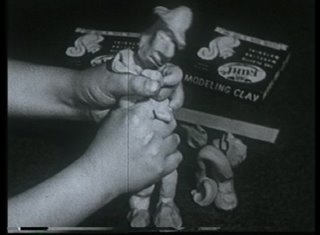
Don’t Get Angry (downloaded from Prelinger Archive).
This mental hygiene film tells kids they should find some non-harmful way to let their anger out, so that it doesn’t get bottled up and result in destructive behavior. Unlike Don’t Be Afraid, it makes its case fairly plausibly, assuming you’re dealing with kids who basically have good self-control most of the time. The “pressure cooker” theory of anger management has since been discredited with people who have serious problems with destructive or abusive behavior, but back in the 50s, you could buy this. The child actors could be better, giving this some camp value, but they could be worse, too. The graphics are great, especially the boiling teakettle image superimposed over the kids’ faces. So are the scenes of using art to express anger––I bet Eddie grew up to be a political cartoonist.Ratings: Camp/Humor Value: ***. Weirdness: ***. Historical Interest: ****. Overall Rating: ***.
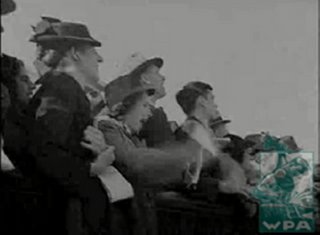
An Amazing Race (downloaded from the Featured Clip Archive of WPA Film Library).
Newsreel story about the 1938 horse racing win of Seabiscuit over War Admiral. This is pretty standard race footage, though the race was close. Still, this shows the superiority of televised sports, where you can watch it as it happens, over seeing a newsreel about it a couple of weeks later.Ratings: Camp/Humor Value: **. Weirdness: **. Historical Interest: ***. Overall Rating: **.
Feeding the Doves (film #8 on The Art of Cinema Begins (Video Yesteryear, 1997). Also available for download on Edison Film Archive. Also, film #8 on The Movies Begin, Volume One: The Great Train Robbery and Other Primary Works (Kino Video, 1994)).
Chickens is more like it, though some doves do land in the chicken yard to share the feast. An 1896 Edison film.Ratings: Camp/Humor Value: *. Weirdness: *. Historical Interest: ***. Overall Rating: **.
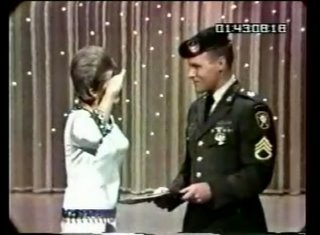
Ballad of the Green Berets (downloaded from Bedazzled).
While the 60s are mainly remembered for its doves, there were also plenty of hawks out there, and they made this song, sung by Sgt. Barry Sadler, a hit. It’s the musical equivalent of the movie Starfighters, which means about all you can say for it is that it’s patriotic and makes the military look good. But boy, is it ever bland. This clip of Sadler singing his hit song on “The Hollywood Palace” deserves preserving, though, for showing us the other side of the 60s.Ratings: Camp/Humor Value: ***. Weirdness: ***. Historical Interest: ****. Overall Rating: ***.
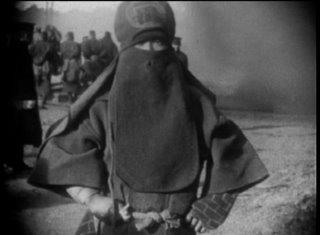
Foreign Fire Depts. (downloaded from Prelinger Archive).
This 30s firefighting film shows us firefighting practices in Japan and Paris. The Japanese footage is most interesting, as it shows us some unusual cultural things, such as the medal-giving ceremony, the decidedly Asian-looking asbestos suits, and effigies of Matoi, the fire god that were believed to protect homes from fire. The Paris footage is pretty standard, featuring demonstrations of various firefighting practices. As with most Stillman films, this has limited entertainment value, but lots of historical interest.Ratings: Camp/Humor Value: **. Weirdness: ***. Historical Interest: ****. Overall Rating: ***.
The Candlemaker (film #12 on Santa’s Holiday Collection DVD (Allegro, 2006)).
This religious cartoon tells the gentle tale of a candlemaker’s young son who is given the task of making one of the altar candles for the church’s Christmas Eve service, and who is ashamed when, after doing a slipshod job at the last minute, the candle doesn’t light. He redeems himself by remaking the candle, just as Jesus can remake a soul. I’m usually pretty hard on religious stuff, as I can’t stomach the usual self-righteousness and treacly sentimentality one finds in such things. But I found it impossible to fault this cartoon in any way. It is never preachy, nor does it ever get sappy. It’s religious message is a reassuring one of forgiveness, which I find refreshing, and it does it all with the lightest and gentlest of touches. This is genuinely recommended for Christmas viewing, though it might be a little slow-moving and subtle for children.Ratings: Camp/Humor Value: N/A. Weirdness: ***. Historical Interest: ***. Overall Rating: ****.
The House in the Middle (available for download from Open Video Project. Also available for download from Prelinger Archive. Also, film #4 on You Can Beat the A-Bomb (Video Yesteryear)).
Did you know that good housekeeping can keep you safe from the atomic bomb? Houses are set up near bomb tests, some neat, some sloppy. The sloppy homes are described with barely concealed derision. "You have all seen homes like this," the narrator says, and we expect him to continue with something like, "...the homes of those weird, non-white people on the wrong side of the tracks." Needless to say, the neat homes survive the bomb lots better than the sloppy homes. "This proves that there is something you can do right now to protect yourself," the narrator continues. The fact that any people in the neat or sloppy homes would be toast is not acknowledged in any way. Appalling.Ratings: Camp/Humor Value: ****. Weirdness: *****. Historical Interest: *****. Overall Rating: ****.

Crash Bang Boom (available on A/V Geeks. Also available for download from Google Video. Also available on You Tube).
Imagine, if you will, that ERPI made a film about percussion instruments. Only imagine it was made in color and in 1970. And it was a musical, with the dry ERPI narration sung instead of spoken. That gives you some idea about what this film is like. Actually, it’s pretty well done visually, with all kinds of percussion instruments filmed and edited in a somewhat wacky style. But then they go and ruin it with a choral group singing incredibly obvious lines like, “This is a bass drum.” They’re not even songs, really, just lame tone poems. Still, this film gets a somewhat higher rating than you might think based on sheer weirdness alone.Ratings: Camp/Humor Value: ***. Weirdness: *****. Historical Interest: *****. Overall Rating: ****.
The Adventures of Ozzie and Harriet (available in the Xmas TV: How Sitcoms Spent the Holidays in the 1960s and 1970s section of TVParty).
Opening sequence from a Christmas episode of “Ozzie & Harriet.” Ozzie announces that the episode is going to be rebroadcast because it shows “the true meaning of Christmas.” Then we see the opening credits, complete with Aunt Jemima pancake mix plug and family introductions. Reruns as the True Meaning of Christmas? I guess there’s some truth to that, when you consider how many times you’ve seen your TV Christmas favorites over and over again.Ratings: Camp/Humor Value: ***. Weirdness: ***. Historical Interest: ****. Overall Rating: ***.
Action Jackson TV Commercials (available on Bedazzled. Also available on Vintage Ads. Also available on You Tube).
Two 70s TV commercials for Action Jackson, an action figure that can go on all kinds of adventures, provided that you buy all the gear that he needs, which is all “sold separately.” How is this different from Barbie, fundamentally, guys? Very 70s, and will probably bring back lots of memories in those who played with action figures during that decade.Ratings: Camp/Humor Value: ***. Weirdness: **. Historical Interest: ****. Overall Rating: ***.

The Association on the Andy Williams Show (downloaded from Bedazzled).
The Association sings their hit favored by swing choirs everywhere, “Cherish.” Then they give wacky introductions, which make them come off as far stranger than I had ever anticipated. Then Andy sings one of their lesser hits with them, and then they do another song by themselves. The only explanation for this sort of weird blandness is the 60s.Ratings: Camp/Humor Value: ***. Weirdness: ***. Historical Interest: ****. Overall Rating: ***.
Impatient Patient (film #4 on Cartoon Crazys: Sci-Fi (WinStar Home Entertainment, 1999). Also, film #23 on 150 Cartoon Classics DVD Megapack (Mill Creek Entertainment, 2005)).
Daffy Duck consults Dr. Jerkyll to cure his hiccups. Of course, Dr. Jerkyll soon turns into Chloe (i.e. Mr. Hyde) and comedy ensues. This is a pretty average Daffy Duck cartoon.Ratings: Camp/Humor Value: ***. Weirdness: ***. Historical Interest: ***. Overall Rating: ***.
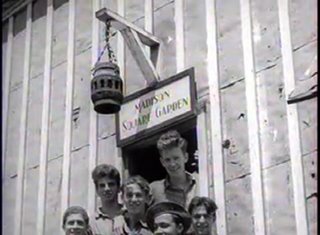
Great Smoky Mountains National Park (downloaded from Google Video). [Category: Public Service]
This Department of the Interior film from the 30s documents the work of the CCC in making improvements to Great Smoky Mountains National Park. This is a typical CCC film, though a bit more rambling than most. There are a few interesting moments, such as a scene in a CCC camp that housed men from New York City that features signs on the barracks identifying the buildings as New York landmarks such as the Astor Hotel or Madison Square Garden. But mostly, this is a fairly uninspired CCC film.Ratings: Camp/Humor Value: **. Weirdness: **. Historical Interest: ***. Overall Rating: ***.
Don't Be Afraid (film #6 on Campy Classroom Classics, Vol. 2 (Something Weird, 2000). Also, extra on Monsters Crash the Pajama Party Spook Show Spectacular DVD (Something Weird, 2001). Also available for download on Open Video Project. Also available for download on Prelinger Archive). [Category: Educational]
Billy is afraid of the dark until his mom gives him a long lecture about real fears vs. imaginary fears, giving lots of examples such as Mom being afraid of a grease fire (real), Kathy being afraid of dogs (imaginary), Billy being afraid to climb up a drainpipe to retrieve a ball (real) and Frank hiding in the basement out of fear of his parents' reaction to his bad report card (imaginary). This film takes place in a charming imaginary world where the worst dangers are grease fires and high places, dogs are friendly creatures that never bite and definitely don't have rabies, and a child with a bad report card hides from his parents because of a terrible misunderstanding, not because of any real fear of abuse by them (the film does admit that the parents "might have been pushing Frank too hard" but the whole thing is resolved in the end and everybody's happy). Note to certain clueless people: This was not the world of the 1950s. This world never existed. There was plenty to be afraid of in the 1950s. Remember the Cold War, for starters? Check out some of the stuff in the Military & Propaganda category if you don't know what I'm talking about.Ratings: Camp/Humor Value: ****. Weirdness: ***. Historical Interest: ****. Overall Rating: ****.
Subscribe to:
Comments (Atom)
Better Reading
Better Reading . Teenager Harold Wilson has a problem—he can’t read for (expletive deleted). So he has to spend all his free time studying ...

-
Better Reading . Teenager Harold Wilson has a problem—he can’t read for (expletive deleted). So he has to spend all his free time studying ...
-
The Best Made Plans. A 50s housewife solves all problems with Saran Wrap plastic film. Of course, all her problems are the kinds we all wa...
-
Annie Oakley – Annie and the First Phone (film #15 in the Classic TV section of Movieflix ). [Category: Early Film & TV] This early-50s ...